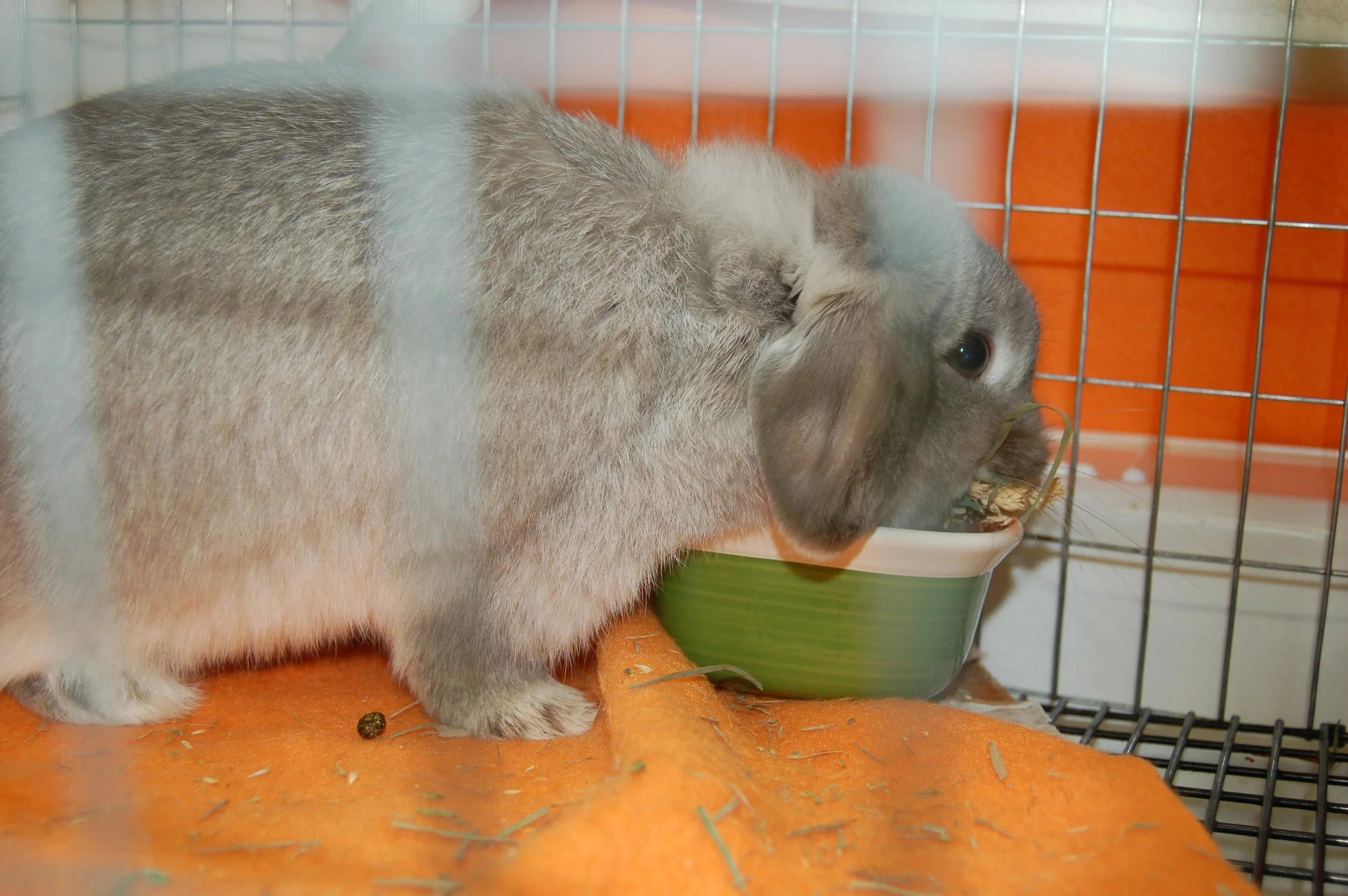Smooth Transitions - Switching Food, Hay or Water Bottles
Transition is like a bad word in the bunny world. After all, most bunnies don't like change. And while it's often unavoidable, you won't convince your bunny of that. How can you make things go more smoothly? In this article we will cover transitions for food, hay and water/water bottles.
If you are bored already - just read this one last sentence:
In a time of transition,
be the thing that stays the same.
Your bunny can weather a lot of change and come through just fine, if it can count on you to be consistent in your attention, love and care. That will be enough to make everything else seem like background noise.
Switching Food
Sometimes this goes seamlessly - and if that is your experience, great. I'm mostly talking to those who are dealing with the opposite scenario. Perhaps you have a bunny like Chubasco, who just refused to switch foods. I followed the normal procedure, adding my food in tiny and increasing increments to the transition food I was given. By the time he was getting 2/3 my food, 1/3 his old food, Chubasco stopped eating. He wasn't even remotely interested. Days passed. I got worried. He was already tiny. How much weight could he afford to lose? Or, maybe your bunny is more creative. I've had several bunnies that magically removed and ate all of their old food, leaving the dish full of my food. Don't think for a second that I layered it. It was all mixed in.
The answer to both of these scenarios is to give your bunny a regular supply of hay in addition to the new food. As long as your bunny continues to eat hay and poop, it's fine. Eventually, and I mean that, your bunny will break down and start eating your food. Chubasco took 2 weeks.
Switching Hay
I've been forced to switch hay a lot. Mind you, it's mostly my own fault. Since I feed my bunnies Sherwood Naturals (which is hay based), it's not essential to have a constant supply, so I've grown lax. I lose track of how much I have left, and then run out. Additionally, sometimes a supplier ran out, or I needed a different kind of hay for nestboxes. All told, I've probably purchased from 8 different suppliers. It's important to point out here that not all hay is the same quality, and some types of hay your bunny just may not like. (Check out our article about hay for more info.) I remember purchasing a large supply of oat hay after hearing how much bunnies love it. None of mine would touch it. Instead, it ended up being stomped through the cage floors and drifting all over the rabbitry. That might seem pretty frustrating, but how about when you buy hay from a pet store and find out that 1/2 the bag is composed of hay shreds only an inch and half long that your bunny can't even find, much less munch on.
The answer is two-fold. First, increase your odds of success and buy from one of these three suppliers: One Ear Up, Farmer Dave (second cutting), or Sherwood Naturals. I've never had a bunny turn these down. Second, serve up the hay in a more inviting form. Stuffing a smaller quantity of hay in a cardboard tube and serving only once a day follows economic principles that your bunny may fall for - reduced supply results in higher demand. One more thought. That money you spent on the hay your bunny couldn't find, or didn't like - it's gone. Chalk it up to a learning experience.
Switching Water/Water Bottles
I can hear people asking if having problems with switching water is even a thing. It is. Here's why. When you buy your bunny, it may have come from a farm with well water, and you are now serving up suburbia. You might have purchased a bunny from the West coast, and live in the MidWest. Believe me, the water is different. When we moved our bunnies from the Great Lakes area, to the SouthWest, they noticed the difference. All of sudden, they weren't drinking enough and their pee was really concentrated. It occurred to me that since it tasted different to me, it likely tasted different to them. Unfortunately, you don't have as much leeway here as you do with the food. Bunnies need to stay hydrated - in cold or hot weather.
The answer is to give your bunnies filtered water. This probably sounds ridiculous, but it certainly isn't that hard to do. Most of us already have filtered water via our refrigerator, an RO system, or even a filter pitcher. It might take a bit more effort, but it's worth it if it keeps your bunny drinking.
One last category - water bottles. There are three basic options here: a valve bottle, a ball bearing bottle, or a water dish. Many breeders us a valve, so when you purchase your bunny, you might find that you want to transition to a water bottle with a ball bearing. One of my customers purchased a bunny from me that had used a ball bearing bottle her whole life - but post her spaying surgery, refused to use it. She ended up using a water dish. If you decide to switch your bunny's water bottle, please determine to pay close attention during the transition. It's so important to make sure that your bunny stays hydrated.
The answer is coax your bunny through the process, essentially educating or training it. In each water container type, the delivery process is different. With a valve, the bunny needs to keep it's teeth pressed up against the valve to keep the water flowing. With a ball, the bunny needs to keep displacing the ball with it's tongue to keep the water flowing. With a dish, your bunny must lick the water up without getting water up their nose. How can you teach your bunny?
* Make your bunny aware of the location of the water. Wait until your bunny finds the new bottle or dish. Next, use a clean hand to activate the ball or valve, and get your finger wet. Finally, put a few water drops on your bunny's mouth.
* Make the water source attractive. One way to do this is to add a little smear of banana. When your bunny starts to lick the banana, they will come in contact with the water.
* Be prepared to intervene to make sure your bunny gets enough water until they are fully transitioned. An easy way to do this is to serve them a handful of greens, dripping with water every day. Worst case scenario, have a tiny syringe and a little pre-made bunny gatorade in the refrigerator on hand in case you need to manually intervene.
Hopefully your bunny goes through each transition smoothly. If not, we hope these tips help. If you are still struggling, feel free to contact us at hickoryridgehollands@gmail.com


